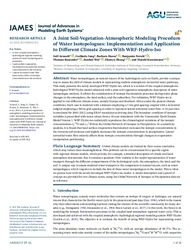A Joint Soil‐Vegetation‐Atmospheric Modeling Procedure of Water Isotopologues: Implementation and Application to Different Climate Zones With WRF‐Hydro‐Iso
Jung, Gerlinde
DOI: https://doi.org/10.1029/2021MS002562
Persistent URL: http://resolver.sub.uni-goettingen.de/purl?gldocs-11858/9836
Persistent URL: http://resolver.sub.uni-goettingen.de/purl?gldocs-11858/9836
Arnault, Joël; Jung, Gerlinde; Haese, Barbara; Fersch, Benjamin; Rummler, Thomas; Wei, Jianhui; Zhang, Zhenyu; Kunstmann, Harald, 2021: A Joint Soil‐Vegetation‐Atmospheric Modeling Procedure of Water Isotopologues: Implementation and Application to Different Climate Zones With WRF‐Hydro‐Iso. In: Journal of Advances in Modeling Earth Systems, Band 13, 10, DOI: 10.1029/2021MS002562.
 |
Dokument öffnen: |
Water isotopologues, as natural tracers of the hydrological cycle on Earth, provide a unique way to assess the skill of climate models in representing realistic atmospheric‐terrestrial water pathways. This study presents the newly developed WRF‐Hydro‐iso, which is a version of the coupled atmospheric‐hydrological WRF‐Hydro model enhanced with a joint soil‐vegetation‐atmospheric description of water isotopologue motions. It allows the consideration of isotopic fractionation processes during water phase changes in the atmosphere, the land surface, and the subsurface. For validation, WRF‐Hydro‐iso is applied to two different climate zones, namely Europe and Southern Africa under the present climate conditions. Each case is modeled with a domain employing a 5 km grid‐spacing coupled with a terrestrial subgrid employing a 500 m grid‐spacing in order to represent lateral terrestrial water flow. A 10‐year slice is simulated for 2003–2012, using ERA5 reanalyses as driving data. The boundary condition of isotopic variables is prescribed with mean values from a 10‐year simulation with the Community Earth System Model Version 1. WRF‐Hydro‐iso realistically reproduces the climatological variations of the isotopic concentrations δPO18 and δPH2 from the Global Network of Isotopes in Precipitation. In a sensitivity analysis, it is found that land surface evaporation fractionation increases the isotopic concentrations in the rootzone soil moisture and slightly decreases the isotopic concentrations in precipitation. Lateral terrestrial water flow minorly affects these isotopic concentrations through changes in evaporation‐transpiration partitioning. Plain Language Summary:
Global climate models are limited by their coarse resolution, which may reduce their meaningfulness. This problem can be circumvented for a specific region with regional climate models, which provide, for example, a detailed description of clouds and land‐atmosphere interactions. But it remains a question: How realistic is the model representation of water transport through the different compartments of the hydrological cycle, the atmosphere, the land, and the sea? A unique way to assess modeled water transport is the comparison to natural tracers, such as water isotopologues, which requires to include the fate of these water isotopologues in the model. This is what we pursue here with the newly developed WRF‐Hydro‐iso model. A model description and a proof of concept are provided for two climate zones, using the Global Network of Isotopes in Precipitation data set as reference. Key Points:
A new coupled atmospheric‐hydrological regional modeling system of water isotopologues is presented.
Land surface evaporation fractionation increases the isotopic concentrations in the rootzone.
Lateral terrestrial water flow has a minor effect on isotopic concentrations in the rootzone.
Statistik:
ZugriffsstatistikSammlung:
Schlagworte:
water isotopologueregional climate modeling
coupled land‐atmosphere pathways
land surface isotopic fractionation
This is an open access article under the terms of the Creative Commons Attribution License, which permits use, distribution and reproduction in any medium, provided the original work is properly cited.

